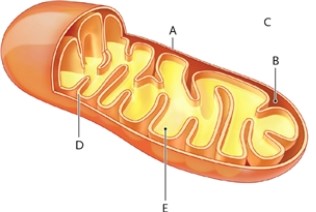A) PEP regulates the activity of phosphofructokinase.
B) PEP can carry out redox reactions.
C) PEP provides high-energy electrons to make ATP.
D) PEP supplies a high-energy phosphate to phosphorylate ADP.
Correct Answer

verified
Correct Answer
verified
Multiple Choice
Which part of the ATP synthase is responsible for catalyzing ATP formation?
A) the basal unit
B) the stalk
C) the headpiece
D) the lollipop-shaped complex
Correct Answer

verified
Correct Answer
verified
Multiple Choice
Which of these statements best explains the energetic status of cellular respiration?
A) It is an exergonic process with negative free energy.
B) It is an endergonic process with negative free energy.
C) It is an exergonic process with positive free energy.
D) It is an endergonic process with positive free energy.
Correct Answer

verified
Correct Answer
verified
True/False
Glycolysis takes place in the mitochondria of a cells.
Correct Answer

verified
Correct Answer
verified
Multiple Choice
Which phrase best describes what occurs during chemiosmosis?
A) the synthesis of ATP by ATP synthase using energy from the proton gradient
B) the buildup of acetate in the cytoplasm in the absence of oxygen
C) the breakdown of oxygen as it enters the mitochondria
D) the production of NADH and FADH2 in cellular respiration
Correct Answer

verified
Correct Answer
verified
Short Answer
Refer to the illustration of a mitochondrion. Match the labelled parts of the mitochondrion with the steps of cellular respiration. A labelled part may be used once, more than once, or not at all.  -pyruvate oxidation
A)outer mitochondrial membrane
B)intermembrane compartment
C)cytosol
D)inner mitochondrial membrane
E)matrix
-pyruvate oxidation
A)outer mitochondrial membrane
B)intermembrane compartment
C)cytosol
D)inner mitochondrial membrane
E)matrix
Correct Answer

verified
Correct Answer
verified
Multiple Choice
Why do cells go through fermentation in our body?
A) to replenish NAD+
B) to replenish O2
C) to replenish FAD
D) to replenish NADH
Correct Answer

verified
Correct Answer
verified
Multiple Choice
Which phrase best describes the chemical conditions inside the mitochondrial matrix?
A) low pH and high pyruvate concentration
B) high pH and high pyruvate concentration
C) high pH and low pyruvate concentration
D) low pH and low pyruvate concentration
Correct Answer

verified
Correct Answer
verified
Multiple Choice
Which of these analogies best illustrates the following: Sugars contain energy, but we have to break them apart to release the energy in order to make the high energy chemical called ATP.
A) electrons of matter
B) photons of light
C) letters in a word
D) books in a library
Correct Answer

verified
Correct Answer
verified
Multiple Choice
Consider the contribution of NADH and FADH2. How many of the 32 total ATP molecules produced in cellular respiration come from oxidative phosphorylation?
A) 20
B) 22
C) 28
D) 30
Correct Answer

verified
Correct Answer
verified
Multiple Choice
In the process of aerobic metabolism, carbon-containing molecules are broken down. What is the energy from the electrons used for?
A) to generate a proton gradient
B) to heat the organism in a cold environment
C) to alter enzyme structure
D) to directly supply the energy needs of an organism
Correct Answer

verified
Correct Answer
verified
True/False
During pyruvate oxidation, one molecule of ATP is produced.
Correct Answer

verified
Correct Answer
verified
True/False
If, during a chemical reaction, a molecule loses hydrogens, it could be described as being oxidized.
Correct Answer

verified
Correct Answer
verified
Short Answer
Refer to the illustration of a mitochondrion. Match the labelled parts of the mitochondrion with the steps of cellular respiration. A labelled part may be used once, more than once, or not at all.  -glycolysis
A)outer mitochondrial membrane
B)intermembrane compartment
C)cytosol
D)inner mitochondrial membrane
E)matrix
-glycolysis
A)outer mitochondrial membrane
B)intermembrane compartment
C)cytosol
D)inner mitochondrial membrane
E)matrix
Correct Answer

verified
Correct Answer
verified
Multiple Choice
Which phrase describes the mechanism that facilitates the passage of electrons between protein complexes in the mitochondrial inner membrane?
A) The oxidized electron carrier protein passes on the electron to FADH and becomes reduced.
B) The reduced electron carrier protein passes on the electron to the next protein and becomes oxidized.
C) The reduced electron carrier protein passes on the electron to FADH and becomes oxidized.
D) The oxidized electron carrier protein passes on the electron to the next protein and becomes reduced.
Correct Answer

verified
Correct Answer
verified
Multiple Choice
Where is ATP synthase located in eukaryotic cells?
A) in the matrix of the mitochondria
B) in the outer membrane of the cell
C) in the nuclear envelope
D) in the inner mitochondrial membrane
Correct Answer

verified
Correct Answer
verified
Multiple Choice
What is the final product of glycolysis?
A) 1 molecule of pyruvate
B) 2 molecules of pyruvate
C) 1 molecule of glyceraldehyde-3-phosphate
D) 2 molecules of glyceraldehyde-3-phosphate
Correct Answer

verified
Correct Answer
verified
Multiple Choice
Which of the following molecules is responsible for carrying the acetyl group from pyruvate into the citric acid cycle?
A) FADH2
B) ATP
C) CoA
D) NADH
Correct Answer

verified
Correct Answer
verified
Multiple Choice
Which statement best describes the function of NADH and FADH2?
A) Both produce ATP by substrate-level phosphorylation.
B) Both transport acetyl-CoA to mitochondria.
C) Both provide electrons to the electron transport system.
D) Both release energy for glycolysis to proceed.
Correct Answer

verified
Correct Answer
verified
Multiple Choice
Which phrase best describes the proton-motive force?
A) the amount of energy required to protonate a glucose molecule
B) the force needed to move protons into the inner mitochondrial space
C) the free energy associated with the removal of hydrogen from NADH
D) the combination of a proton and voltage gradient across the membrane
Correct Answer

verified
Correct Answer
verified
Showing 41 - 60 of 61
Related Exams